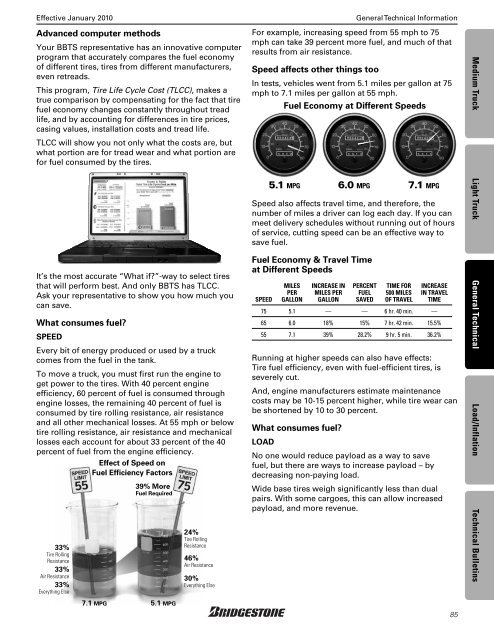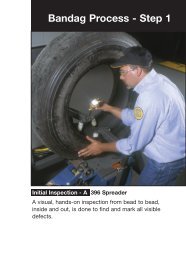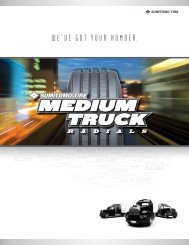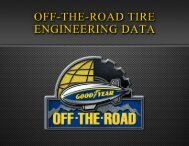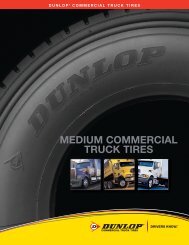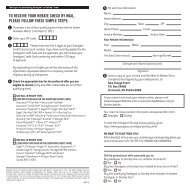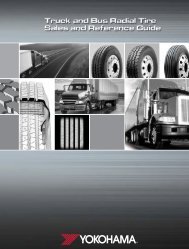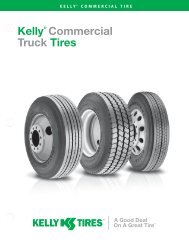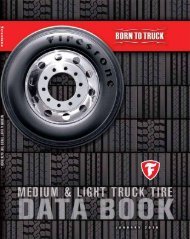Bridgestone Medium and Light Truck Tire Data Book - Sullivan Tire ...
Bridgestone Medium and Light Truck Tire Data Book - Sullivan Tire ...
Bridgestone Medium and Light Truck Tire Data Book - Sullivan Tire ...
You also want an ePaper? Increase the reach of your titles
YUMPU automatically turns print PDFs into web optimized ePapers that Google loves.
Effective January 2010<br />
General Technical Information<br />
Advanced computer methods<br />
Your BBTS representative has an innovative computer<br />
program that accurately compares the fuel economy<br />
of different tires, tires from different manufacturers,<br />
even retreads.<br />
This program, <strong>Tire</strong> Life Cycle Cost (TLCC), makes a<br />
true comparison by compensating for the fact that tire<br />
fuel economy changes constantly throughout tread<br />
life, <strong>and</strong> by accounting for differences in tire prices,<br />
casing values, installation costs <strong>and</strong> tread life.<br />
TLCC will show you not only what the costs are, but<br />
what portion are for tread wear <strong>and</strong> what portion are<br />
for fuel consumed by the tires.<br />
It’s the most accurate “What if”-way to select tires<br />
that will perform best. And only BBTS has TLCC.<br />
Ask your representative to show you how much you<br />
can save.<br />
What consumes fuel<br />
SPEED<br />
Every bit of energy produced or used by a truck<br />
comes from the fuel in the tank.<br />
To move a truck, you must first run the engine to<br />
get power to the tires. With 40 percent engine<br />
efficiency, 60 percent of fuel is consumed through<br />
engine losses, the remaining 40 percent of fuel is<br />
consumed by tire rolling resistance, air resistance<br />
<strong>and</strong> all other mechanical losses. At 55 mph or below<br />
tire rolling resistance, air resistance <strong>and</strong> mechanical<br />
losses each account for about 33 percent of the 40<br />
percent of fuel from the engine efficiency.<br />
Effect of Speed on<br />
Fuel Efficiency Factors<br />
33%<br />
<strong>Tire</strong> Rolling<br />
Resistance<br />
33%<br />
Air Resistance<br />
33%<br />
Everything Else<br />
39% More<br />
Fuel Required<br />
24%<br />
<strong>Tire</strong> Rolling<br />
Resistance<br />
46%<br />
Air Resistance<br />
30%<br />
Everything Else<br />
For example, increasing speed from 55 mph to 75<br />
mph can take 39 percent more fuel, <strong>and</strong> much of that<br />
results from air resistance.<br />
Speed affects other things too<br />
In tests, vehicles went from 5.1 miles per gallon at 75<br />
mph to 7.1 miles per gallon at 55 mph.<br />
Fuel Economy at Different Speeds<br />
5.1 MPG 6.0 MPG 7.1 MPG<br />
Speed also affects travel time, <strong>and</strong> therefore, the<br />
number of miles a driver can log each day. If you can<br />
meet delivery schedules without running out of hours<br />
of service, cutting speed can be an effective way to<br />
save fuel.<br />
Fuel Economy & Travel Time<br />
at Different Speeds<br />
SPEED<br />
MILES<br />
PER<br />
GALLON<br />
INCREASE IN<br />
MILES PER<br />
GALLON<br />
PERCENT<br />
FUEL<br />
SAVED<br />
TIME FOR<br />
500 MILES<br />
OF TRAVEL<br />
INCREASE<br />
IN TRAVEL<br />
TIME<br />
75 5.1 — — 6 hr. 40 min. —<br />
65 6.0 18% 15% 7 hr. 42 min. 15.5%<br />
55 7.1 39% 28.2% 9 hr. 5 min. 36.2%<br />
Running at higher speeds can also have effects:<br />
<strong>Tire</strong> fuel efficiency, even with fuel-efficient tires, is<br />
severely cut.<br />
And, engine manufacturers estimate maintenance<br />
costs may be 10-15 percent higher, while tire wear can<br />
be shortened by 10 to 30 percent.<br />
What consumes fuel<br />
LOAD<br />
No one would reduce payload as a way to save<br />
fuel, but there are ways to increase payload – by<br />
decreasing non-paying load.<br />
Wide base tires weigh significantly less than dual<br />
pairs. With some cargoes, this can allow increased<br />
payload, <strong>and</strong> more revenue.<br />
<strong>Medium</strong> <strong>Truck</strong> <strong>Light</strong> <strong>Truck</strong> General Technical Load/Inflation Technical Bulletins<br />
7.1 MPG 5.1 MPG<br />
85


